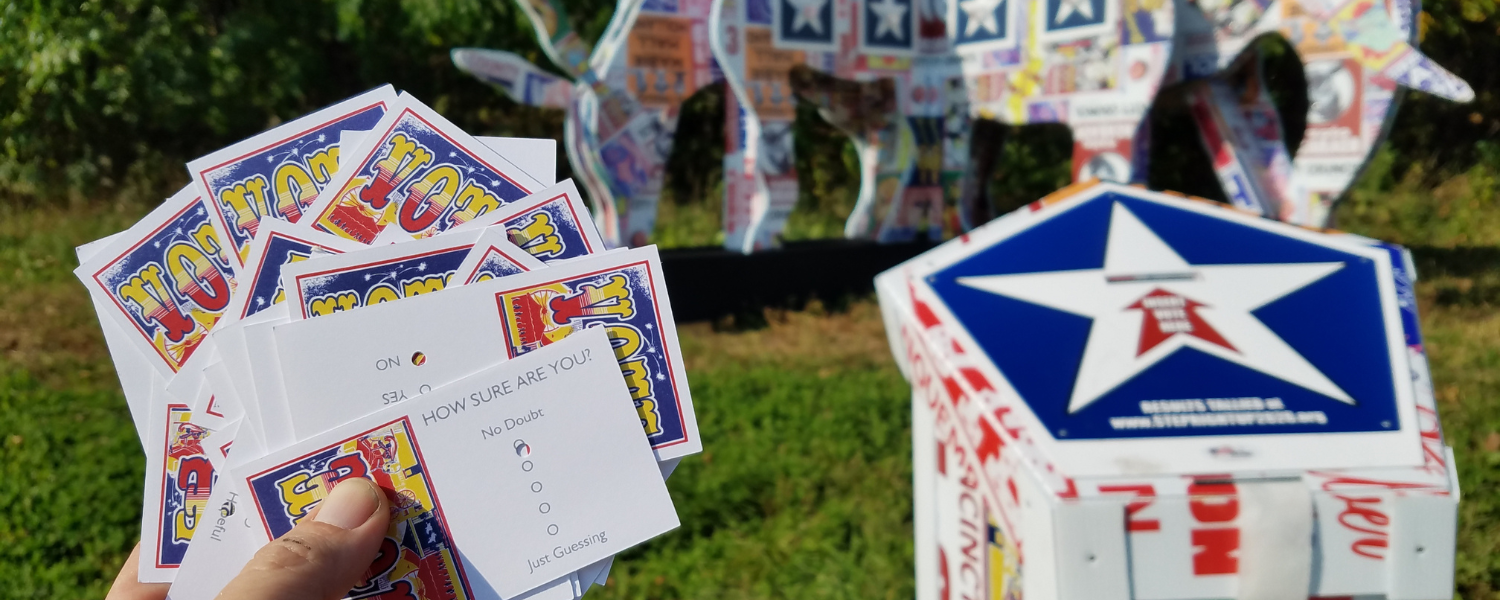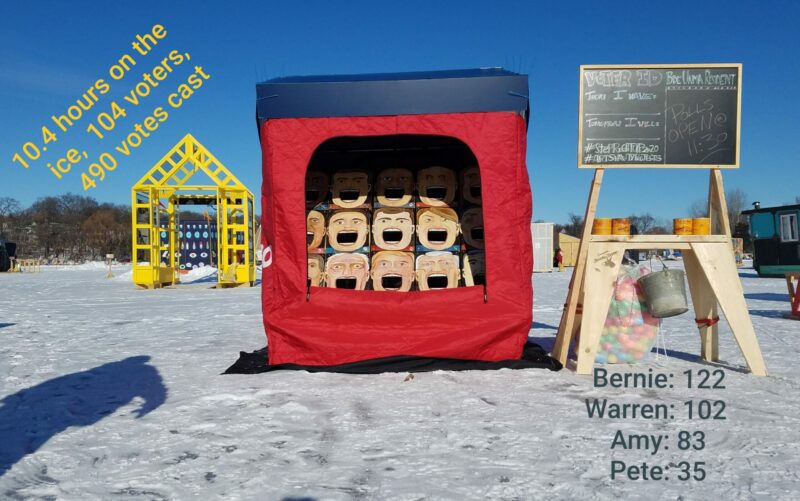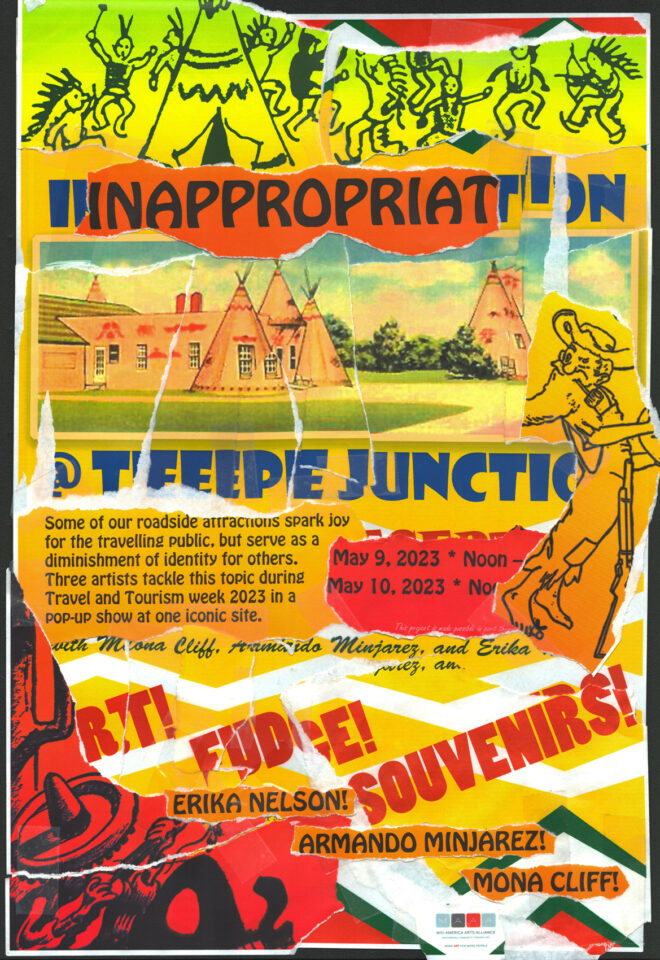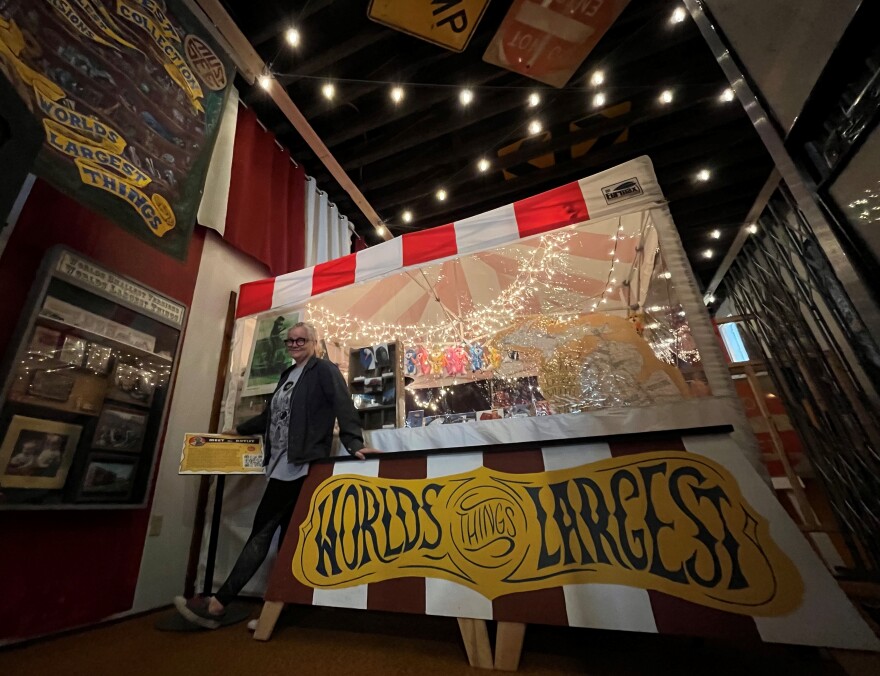Erika Nelson, Inappropriation along the American Road and Step Right Up! Voting Booth
By Becky Brown

Art is for everyone—and can be by everyone, too.
One Kansas artist’s socially engaged practice explores the beauty that can be found not in galleries but in the wild: along roadsides and in communities.
Ask a kid what they want to be when they grow up, and their answer will probably sound like something from a Richard Scarry book: truck driver, teacher, doctor. Why don’t those books include roles like foremost expert on roadside attractions and “world’s largest” landmarks?
Probably because Erika Nelson already has that job. An independent artist and educator based in Lucas, Kansas, Erika explores intuitive art in public spaces. She’s often off the beaten path, in search of the odd and unusual. It’s art made by everyday people—with extraordinary results.
“All you need to be an artist is to make art. All the rest is a lot of words,” Erika says. “I think that’s what we forget in talking about art or teaching art or attending conferences about art. It’s really about people making stuff to make their lives better.”
Making stuff can also be social practice art.

“Votes on Ice, part of the “Step Right Up! Voting Booth” project by Erika Nelson.
Erika created Step Right Up! Voting Booth as a combination of sideshow carnival, fine art, and social practice. Complete with hand-painted carnival punks, the project asked participants to exercise their right to vote. Planned for 2020, Erika designed the experience to tour states with histories of voting access issues.
Mid-America Arts Alliance’s Interchange artist program, which supports socially engaged artists, awarded Erika a grant of $20,000 to support Step Right Up! Voting Booth. By extension, it also supported Erika’s art practice and the artist herself during a tumultuous time.
“Because it overlapped with the pandemic, it became a support grant,” she says. “I got to do the first iteration of the voting access project, then there was the pandemic, then I did the last iteration.”
Erika soon developed her next project, Inappropriation along the American Road along with collaborators Mona Cliff and Armando Minjarez. Focused on tourist attractions with outdated stereotypes, this work challenged representations like sombrero-wearing Mexican Americans, drunken hillbillies, and Indigenous teepee dwellers.
Exhibition images and texts were distributed at roadside attractions like La Salsa Man in Dodge City, Kansas, and TeePee Junction in Lawrence, Kansas. It’s socially engaged art that provides a direct response to commercialized and stereotypical nostalgia. M-AAA’s 2023 Artistic Innovations Grant helped make it happen.
Engaging community through art creates ripples in awareness, creativity, and community.

“Inappropriation along the American Road” poster by Erika Nelson.
Inappropriation along the American Road enjoys another life as Erika displays parts of the exhibit at her Roadside Sideshow Expo art center in Lucas. There, she reports it continues to “subtly change perceptions.” And artist Armando Minjarez includes his plaster casts from the project in his solo shows.
Based on her experiences, Erika also spreads the word about the power of activist art. She recently spoke at the College Art Association’s annual conference about print on demand tools.
“Artists are using print on demand to produce objects that open up conversations about voting instead of closing them down,” she says. “Artists can use print on demand to subvert norms in a way that’s just as radical as people who use print on demand to fuel division.”
This cultural activism can find a place anywhere.
Like Lucas, Kansas. With a population hovering around 400, you might not expect to find the foremost expert on roadside attractions and “world’s largest” landmarks. But this community is Erika’s home.
Here, she tends to the artistic legacy of S.P. Dinsmoor’s Garden of Eden art environment as cultural resources director. Erika also creates and curates the World’s Largest Collection of the World’s Smallest Versions of the World’s Largest Things Traveling Roadside Attraction and Museum. And she’s at the helm of Woodpecker Archives, her artistic workspace that features a rotation of large-scale prints in the windows. With works ranging from nature images to Picasso’s Guernica, this socially engaged practice both responds to and shapes the community.
“It’s a really, really large reminder of what art can respond to,” Erika says.
None of these projects occurs in a vacuum. One work easily leads into another.
“It’s really good to connect to what you’ve springboarded into creative practice,” Erika says. “Projects don’t end at the end . . . you use that idea again to expand into even greater relevance.”

Erika Nelson with the World’s Largest Collection of the World’s Smallest Versions of the World’s Largest Things Traveling Roadside Attraction and Museum at the expo art center in Lucas, Kansas. Photo by David Kondos.
This chain of social practice art is possible thanks in part to ongoing support from programs like M-AAA’s Interchange, which now provides practice-based grants, also known as trust-based grants. Unlike project-based grants, practice-based grants don’t require an artist to attach funds to a specific project. Artists can use the funds to support their practice, whatever that means to them.
“The best way to support artists is to support artists,” Erika says. “When you run into a project-based grant, it can be intimidating. ‘What if I don’t have this grand idea?’ Funding practice-based grants creates a better balance.”
*The Intuit: Center for Intuitive and Outsider Art defines outsider art as “the work of artists who demonstrate little influence from the mainstream art world and who are, instead, motivated by their unique personal visions.” Read the full description here.
Header photography: Your Voices Your Votes, October 2020, by Erika Nelson. FY19 Interchange grantee.

